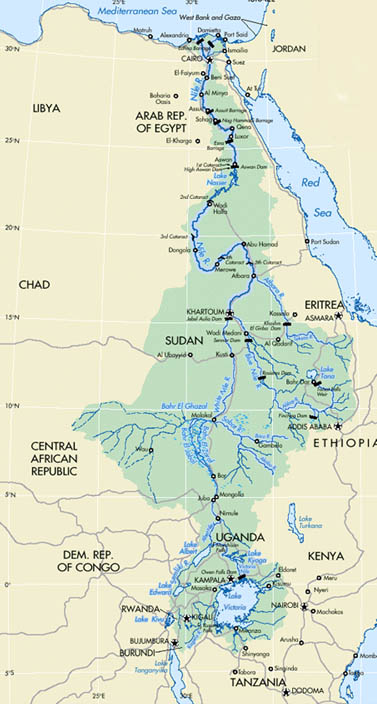Nile river information - The longest river in the world
 The Nile is the longest river in the world of 6650 km
(4132 miles) flows from central Africa to the shores of the
Mediterranean in the north of Egypt. Herodotus called Egypt
the gift of the Nile as the ancient Egyptian civilization
grew alongside the river more than 7000 thousand years. The
Nile name originates from the Greek word "Nelios" which
means River Valley. The Nile is the longest river in the world of 6650 km
(4132 miles) flows from central Africa to the shores of the
Mediterranean in the north of Egypt. Herodotus called Egypt
the gift of the Nile as the ancient Egyptian civilization
grew alongside the river more than 7000 thousand years. The
Nile name originates from the Greek word "Nelios" which
means River Valley.
There are two main sources of the Nile, the blue Nile
that flows from the Ethiopian Tana lake and the white Nile
which source is Victoria lake. The Nile river flows through
nine countries Uganda, Sudan, Egypt, Ethiopia, Kenya, Zaire,
Tanzanian, Burundi, and Rwanda. All nine countries of the
Nile basin have signed a treaty giving each country a fair
share of the Nile river water. According to the treaty Egypt
the right of veto over any work which might threaten the
flow of the river. The Nile Water Agreement of 1929 grants
Egypt 55.5 billion cubic meters of water, out of a total of
84 billion cubic meters to cover its requirements of water
consumption and development projects.
Dams on the Nile
There are several dams on the Nile river which were built
to raise the water level, serve as reservoirs and generate
electricity. Major dams on the Nile are:
- Sennar Dam (Sudan) built in 1925.
- Roseires Dam (Sudan) built in 1966
- Aswan High Dam (Egypt) built 1960-1970
- Owen Falls Dam (Uganda) completed in 1950
Egypt relies on the Nile river to get its needs of water
for irrigation of its crops as agriculture is one the main
activities in Egypt and a major source of income. Building
of the High dam in Aswan has big impact on the quality of
the cultivated land as it prevented the transport of fertile
silt carried over the flooding inflow from lake Tana through
the blue Nile to the Nile valley in Egypt.
- Nile cruise booking
Several cruise ships to choose from to book a Nile
cruise tour at good prices.
|